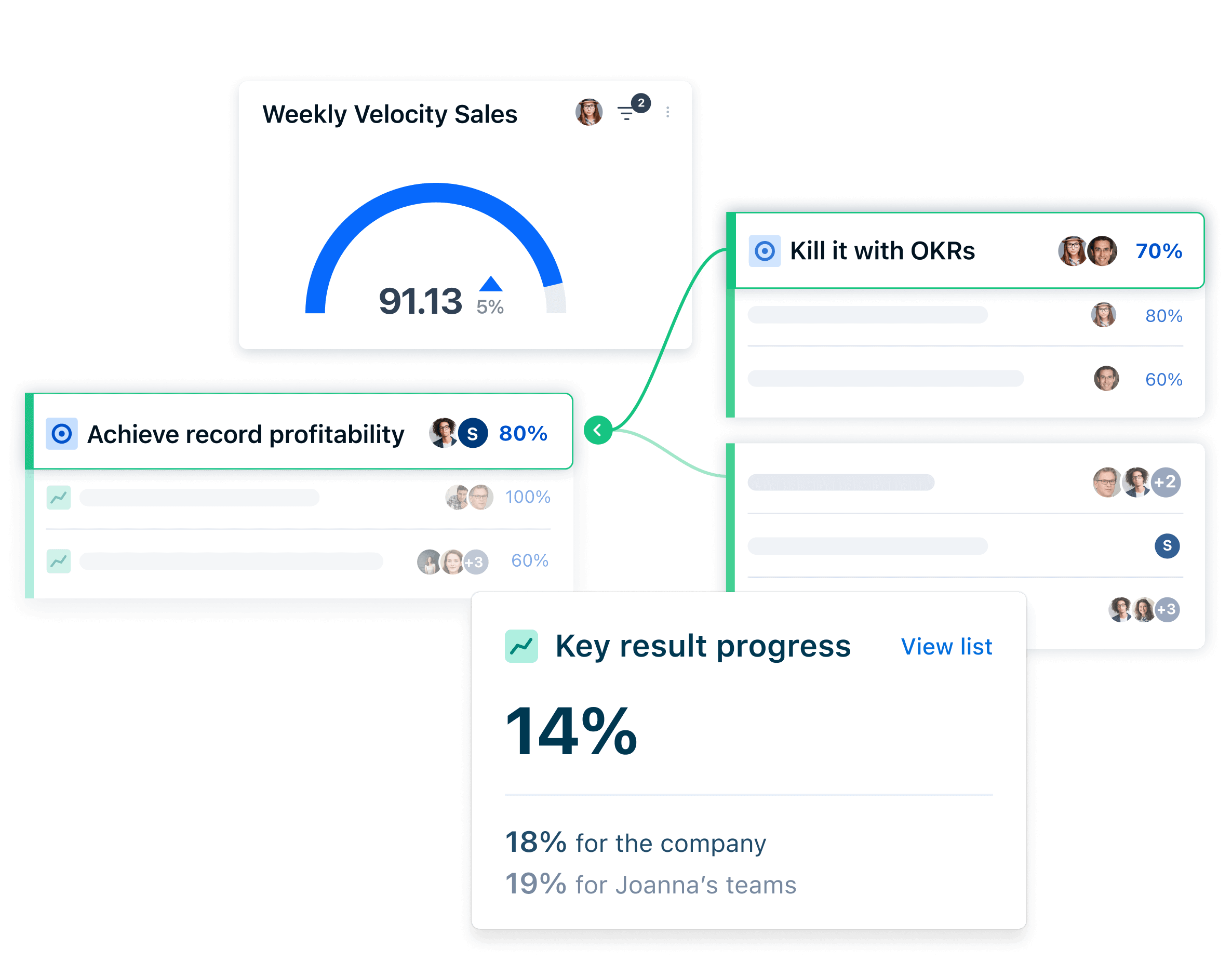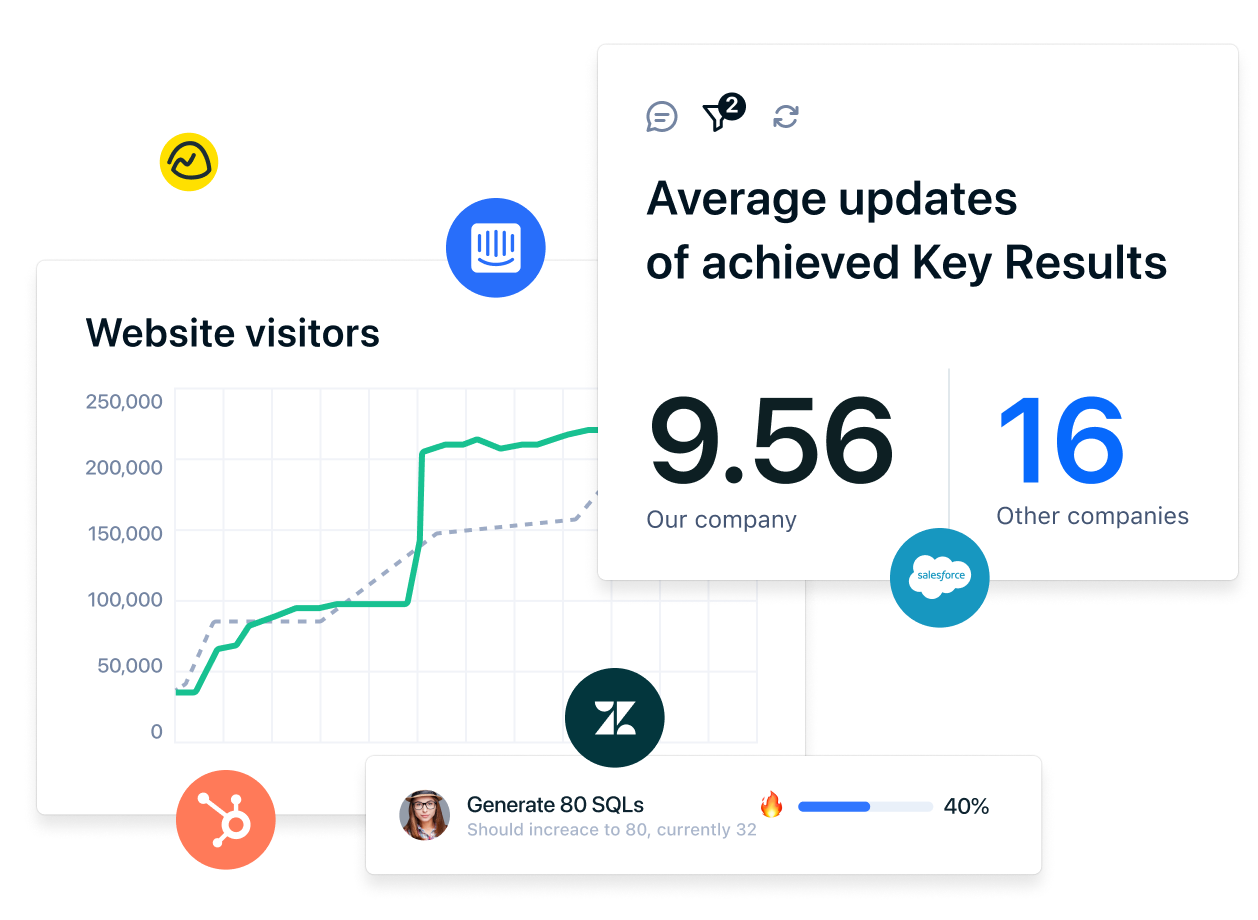What are OKRs in business?
All businesses need a concrete understanding of where they’re headed to drive purposeful action and win in the future of work. Whether it’s startups powering through the initial stages of development, SMBs working to capture market share, or enterprises looking to innovate, companies must commit to goals to attain their desired outcomes.
Objectives and key results (OKRs) are a great way for organizations to achieve their goals. OKRs in business can be a powerful goal-setting framework used to set ambitious, collaborative, and time-bound goals.
This framework uses two components to set and track goals: objectives and key results. Objectives refer to short, qualitative descriptions of what a business wants to achieve. Each objective is accompanied by 3-5 metric-driven key results that are used to track progress toward each objective.
Using measurable and transparent progress indicators, collaborative goal-setting, and a flexible approach to goal fulfillment, OKRs in business can help address customer needs and streamline procedures.
To show you the power of OKRs in business, this article covers the benefits of OKRs for startups, small and medium-sized businesses (SMBs), and enterprises. Additionally, it covers examples of OKRs for each type of organization.
How are OKRs used in business?
Regardless of company size, Using OKRs in business can help them point their efforts and resources in the right direction.
OKRs can help individual departments set goals that align with the company's objectives. How each department would craft and apply OKRs depends on that department's role in advancing the company's overall objectives.
For example:
- The sales team may create OKRs that focus on revenue generation if the company objective involves boosting revenue
- The marketing department may implement OKRs to double down on lead generation if the company objective focuses on skyrocketing customer acquisition
- The operations team may use OKRs to drive their efficiency and productivity if the company objective emphasizes reducing operational costs
See more examples of OKRs in business departments

10 benefits of OKRs for businesses
OKRs in business can be valuable tools regardless of size or industry, catering to needs across the business lifecycle. Startups, SMBs, and enterprises can see many benefits of OKRs. These include:
- Strengthen alignment
- Foster a culture of innovation
- Drive transparency and accountability
- Boost productivity and engagement
- Enhance adaptive capabilities
- Optimize resource allocation and management
- Enable continuous learning and improvement
- Improve cross-functional collaboration
- Enhance decision-making
- Encourage employee skill development
1. Strengthen alignment
As one of the key benefits of OKRs, leveraging OKRs in business can improve alignment and resource coordination. OKR goals can create tight linkages between employees, operations, and processes, aligning them toward one mission. This alignment clarifies the business's direction and simplifies operations, with employees focusing on a common goal without requiring complex communication systems.
2. Foster a culture of innovation
OKRs' ambitious nature can cement creativity and trial and error into the core of company operations. As OKRs in business involve stretch goals that aren't — or at least shouldn't be — tied to compensation, they encourage less risk aversion and more experimentation. This key benefit of OKRs driver innovation and lateral thinking.
3. Drive transparency and accountability
OKRs promote a transparent work environment where OKRs and OKR progress are accessible throughout the organization. The benefits of OKRs in driving transparency and accountability are evident.This transparency encourages accountability as employees are more aware of their responsibilities, how these are performing, and how their work contributes to the broader company objectives. This can lead to a stronger sense of ownership and responsibility.
4. Boost productivity and engagement
The benefits of OKRs are clear in boosting productivity and engagement. OKRs can improve engagement and productivity in businesses of all sizes. Through collaborative goal-setting, regular updates on progress, and clear ownership of goals, OKRs in business ensure employees are kept motivated, accountable, and highly productive throughout the OKR cycle.
5. Enhance adaptive capabilities
The OKR framework is a powerhouse of agility and flexibility, encouraging companies to deploy resources in response to shifts in the market environment. As OKRs in business can be continuously updated throughout the OKR cycle — adjustable to a company's OKR cadence — they help companies seamlessly pivot strategies as they make sustainable progress toward long-term goals.
6. Optimize resource allocation and management
Utilizing OKRs in business operations encourages organizations to funnel resources toward what matters most. For example, companies can use their annual and quarterly OKR progress to assess the effectiveness of their resource allocation. Moreover, as stretch goals require businesses to make the most of what they have, OKRs help businesses maximize the utility and capability of their resources.
7. Enable continuous learning and improvement
OKRs are not just about achieving targets but also about learning from the process. They encourage regular reflection and assessment of what worked and what didn't through OKR check-ins and retrospectives. This continuous learning promotes ongoing improvements over time, enabling businesses to adapt, evolve, and transform in response to changing circumstances and market dynamics.
8. Improve cross-functional collaboration
OKRs encourage teams from different departments to come together, ensuring their efforts are synergetic and align with broader company objectives. The benefits of OKRs in improving cross-functional collaboration are significant. This breaks down silos and fosters cross-functional collaboration, leading to an integrated and unified organization that pools its resources and talent together to achieve united outcomes.
9. Enhance decision-making
By outlining clear objectives and measurable key results, OKRs empower decision-makers with valuable insights into what they value most. This clarity enables more informed and data-driven decision-making, as leaders can easily identify where resources should be allocated and what strategies should be pursued to achieve defined objectives.
10. Encourage employee skill development
The OKR framework goes beyond mere goal-setting. The benefits of OKRs extend to encouraging employee skill development. By encouraging individuals to develop and take ownership of ambitious objectives and key results, the framework creates opportunities for employees to acquire new skills and competencies. To achieve their ambitious OKRs, they may need to build and enhance their abilities — individually and as part of a team. This process not only benefits individual career advancement but also strengthens the overall skill set of the organization.
Discover why top leaders use OKRs in our Global State of OKRs Report

How OKRs help startups
OKRs, or objectives and key results, can assist startups in navigating the challenging path toward growth and success. Startups may encounter several hurdles when working to streamline their processes. Equipped with the benefits of OKRs in business, startups can alleviate the impact of these hurdles and sustain superior performance. Here are a few ways that OKRs can help startups.
OKRs help startups create a clear vision
OKRs help startups establish clear and measurable objectives, outlining what they aim to achieve within a specific time frame. This clarity is vital for startups, which often face uncertainty and rapid changes during their early stages. By setting well-defined objectives, startups can direct their limited resources and efforts toward their most critical OKRs, avoiding the common trap of spreading themselves too thin. This focused approach enables startups to make strategic decisions in alignment with their overarching mission, which is crucial for sustained growth.
OKRs help startups communicate goals
As startups solidify their communication plan, employees may miscommunicate or work towards disparate goals. To overcome this, startups can establish a companywide OKR (i.e., a North Star goal) to guide employees' efforts and nourish steady, focused growth.
OKRs help startups position themselves against competitors
OKRs can also help startups position themselves against big competitors. As OKR stretch goals encourage innovative thinking — simultaneously facilitating employee engagement and productivity — the use of OKRs in business can improve startups’ offerings and propel them to new heights of achievement.
OKRs keep startups adaptable
Moreover, startups can use OKRs to stay adaptable. As startups lack deep-rooted internal processes and require experimental approaches to business, they can rely on OKRs to remain flexible in dynamic environments.
OKRs help startups continuously improve
OKRs foster a culture of continuous improvement, accountability, and transparency within startups. The framework encourages innovation and adaptability with its iterative and cyclical nature. This allows startup teams to update, refine, and pivot their objectives and key results in response to changing market conditions and customer feedback, providing much-needed agility. Beyond agility, OKR check-ins drive accountability, as these transparent progress checks create a regular cadence of reviews against key results. Overall, OKRs can be a powerful tool for startups, helping them stay focused, aligned, and adaptable as they work towards their goals.
With OKRs' quantitative and trackable nature, startups can assess the effectiveness of their resource allocation, overcome periods of volatility, and thrive amidst uncertainty.
How OKRs help small and medium businesses
The benefits of OKRs can also support SMBs, helping them overcome the challenges of scaling operations.
As SMBs grow, they may find it challenging to scale internal networks uniformly. This can cause disruptions when transmitting information, know-how, and experience. As OKRs in business facilitate alignment at every level, SMBs can use these to calibrate operations and avoid operational barriers.
Additionally, as employees in SMBs must wear many hats to minimize the lag between resource and company growth, SMBs need to focus on employee engagement. With OKRs promoting the ownership of ambitious goals, employees are encouraged to stay motivated and productive.
Employee engagement is also essential for SMBs switching focus from survival to growth. This change entails a forward-thinking approach to operations, often missing in SMBs due to their previous focus on survival and risk aversion. Using OKRs in business, SMBs can integrate innovation and adaptability into their operations, leveraging limited resources to suit ever-changing market needs.
See how OKRs support small and medium businesses

How OKRs help enterprises
Due to their sheer size, enterprises face different challenges than startups and SMBs. Yet, OKRs can still be an optimal solution for these businesses, as this framework’s flexibility can be incredibly beneficial for large organizations as well.
Misalignment and miscommunication are common issues faced by enterprises with extensive, hybrid teams. As these challenges can cause duplicate, redundant, and inconsistent work, using OKRs in business can assure goal alignment and visibility around resource use.
Alignment and visibility are essential for large organizations with legacy hierarchies, cascaded decision-making, and silos. Employees in such businesses may fail to see the positive contributions of their work, causing disengagement and feelings of disconnect. As OKRs encourage accountability around aspirational goals, they can be a viable solution for large businesses, facilitating employee engagement, productivity, and retention.
Moreover, legacy organizations’ existing success can make them less keen on innovating and more reliant on tried-and-tested methods. This can keep them dormant and may result in a loss of market share as existing market unpredictabilities require businesses to mold to external changes. Using OKRs as a powerhouse for innovation and agility ensures enterprises avoid stagnation, push growth, and whether the ebbs and flows of the market environment.
See how OKRs can support enterprise businesses

OKR examples for businesses of different sizes
OKRs for startups
OKR example 1
- Objective: Boost brand awareness
- Key result 1: Increase share of voice on social media to 16%
- Key result 2: Increase referral traffic by 70%
- Key result 3: Increase organic web traffic by 25%
OKR example 2
- Objective: Be on track to secure seed funding
- Key result 1: Increase customer base to 500
- Key result 2: Increase activation rate to 25%
- Key result 3: Increase NPS from 31 to 50
OKR example 3
- Objective: Improve product-market fit
- Key result 1: Increase signup rate by 5%
- Key result 2: Increase conversion rate by 10%
- Key result 3: Reduce time to value by 2 minutes
- Key result 4: Increase user-level cohort retention to 35%
OKRs for SMBs
OKR example 1
- Objective: Solidify diversity, equity, and inclusion (DEI) into the company
- Key result 1: 100% participation rate in employee DE&I training modules
- Key result 2: Increase the percentage of diverse employees from 45% to 60%
- Key result 3: Improve our current policy on DE&I as part of our internal code of conduct
OKR example 2
- Objective: Skyrocket revenue to an all-new high
- Key result 1: Hit quarterly revenue of $5’000’000
- Key result 2: Increase conversion rates from SQL to opportunity to 13%
- Key result 3: Upsell to 25% of existing customers
- Key result 4: Reduce churn rate by 2.5%
OKR example 3
- Objective: Improve customer satisfaction
- Key result 1: Boost Net Promoter Score from 5.8 to 7
- Key result 2: Decrease the number of complaints from 12 to 8
- Key result 3: Gain feedback from 50 lapsed customers
OKRs for enterprises
OKR example 1
- Objective: Accelerate our global growth
- Key result 1: Hire 50 new personnel at our EMEA offices
- Key result 2: Achieve $500M in total global sales
- Key result 3: Produce localized marketing materials in our top 6 geographical markets
OKR example 2
- Objective: Speak the language of our prospects
- Key result 1: Hire a country manager for each of our top 6 geographical markets
- Key result 2: Release localized website in our top 6 geographical markets
- Key result 3: Produce 2 new ad creatives for each of our top 6 geographical markets
OKR example 3
- Objective: Crown the customer
- Key result 1: Gather feedback from 10 customers each month
- Key result 2: Reduce customer support ticket response times to 2 hours
- Key result 3: Increase customer retention to 90%
OKR example 4
- Objective: Supercharge our company culture
- Key result 1: Execute a company fitness challenge with 85% participation
- Key result 2: Produce a summary of results from employee engagement surveys
- Key result 3: Achieve 100% positive feedback on this year’s holiday party
Using OKRs in your business
Businesses must be proactive about setting and accomplishing goals at every stage of their lifecycle. Startups, SMBs, and enterprises can use OKRs in business to facilitate alignment, spearhead innovation, optimize resource allocation, boost performance, and improve flexibility.
The benefits of OKRs are indispensable, helping you maintain a competitive edge while continuously exceeding performance expectations. Using the right strategy execution platform for your business, you can plan, align, execute, assess, and adapt your OKRs to ongoing growth and success. See how you can use Quantive to create a tailored strategy execution here.
Quantive empowers modern organizations to turn their ambitions into reality through strategic agility. It's where strategy, teams, and data come together to drive effective decision-making, streamline execution, and maximize performance.
As your company navigates today’s competitive landscape, you need an Always-On Strategy to continuously bridge the gap between current and desired business outcomes. Quantive brings together the technology, expertise, and passion to transform your strategy from a static plan to a feedback-driven engine for growth.
Whether you’re a visionary start-up, a mid-market business looking to conquer, or a large enterprise facing disruption, Quantive keeps you ahead — every step of the way. For more information, visit www.quantive.com.

